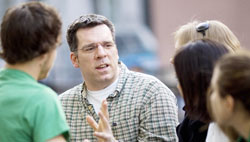Changing the world: Students explore service potential

Gilbert Émond talks with some of his students outside the Hall Building in preparation for their exhibit.
Photo by andrew dobrowolskyj
On April 6, first-year Applied Human Sciences students will tell the world how they would make it a better place.
The exhibition, called “Yes! We Can Change Something in the World,” will display the results of the work of approximately 130 students who took the Introduction to Human Systems Intervention class this term.
The course required the students to form groups and analyze a human system – a group in which humans interact – in the greater Montreal area.
They became familiar with their subjects through interviews, direct observation and scholarly research. Their objective was to identify faults in those systems and to find ways to improve them.
A group who worked on abortion clinics, for example, focused on a private clinic and a local CLSC in Montreal. The group found that these clinics did not provide adequate psychological support for women who underwent abortions.
Dana Twik, a student who worked on that project, said that her group considered counselling necessary for women who have an abortion because they risk developing post-traumatic stress disorder and/or depression. That may invalidate the efficacy of the clinics as human systems, she said.
Professor Gilbert Émond, who teaches the course, said although no groundbreaking discoveries were made through the project, all the students took their first steps in understanding how changing little things may have a larger impact.
Improving the wellbeing of communities, organizations, groups, families and relationships is exactly what applied human sciences set out to do. The professor said that the catchphrase “real education for the real world,” is perfectly applicable to this course.
“If one teaches students how to analyze their surroundings, one gives them instruments to make a difference,” he said.
Twik agreed. “We learn a lot in class, but there is nothing like applying your knowledge to real life. We are already practicing what we’ve learned and that will be of great help in our professional future.”
She added that the exhibition will give her and her colleagues the chance to receive feedback on their ideas. “If one day we work for an organization, we need to know what the public thinks before we carry out an intervention.”
This is the first time Émond has taught this course, since he only started working at Concordia last July. After completing a master’s in mathematics and a PhD from UQAM in communications, Émond was happy to accept a position as assistant professor in human systems intervention.
“It’s the best fit I’ve found so far,” he said. “My wish as a professional is to solve complex problems. Human systems are surely complex.”
His areas of expertise include HIV prevention and gay health issues. He is also the co-author of a book, Sudoku 201: L’énigme, set to be released later this month, which explores why the Japanese number puzzle has become so popular.
“There is a big cloud up there, but we can’t see through it,” he said. “The real challenge is here, in the real world.”
“Yes! We Can Change Something in the World” is open to the public from 6 to 8 p.m. on Thursday, April 6. It is on the mezzanine of the Hall Building.
